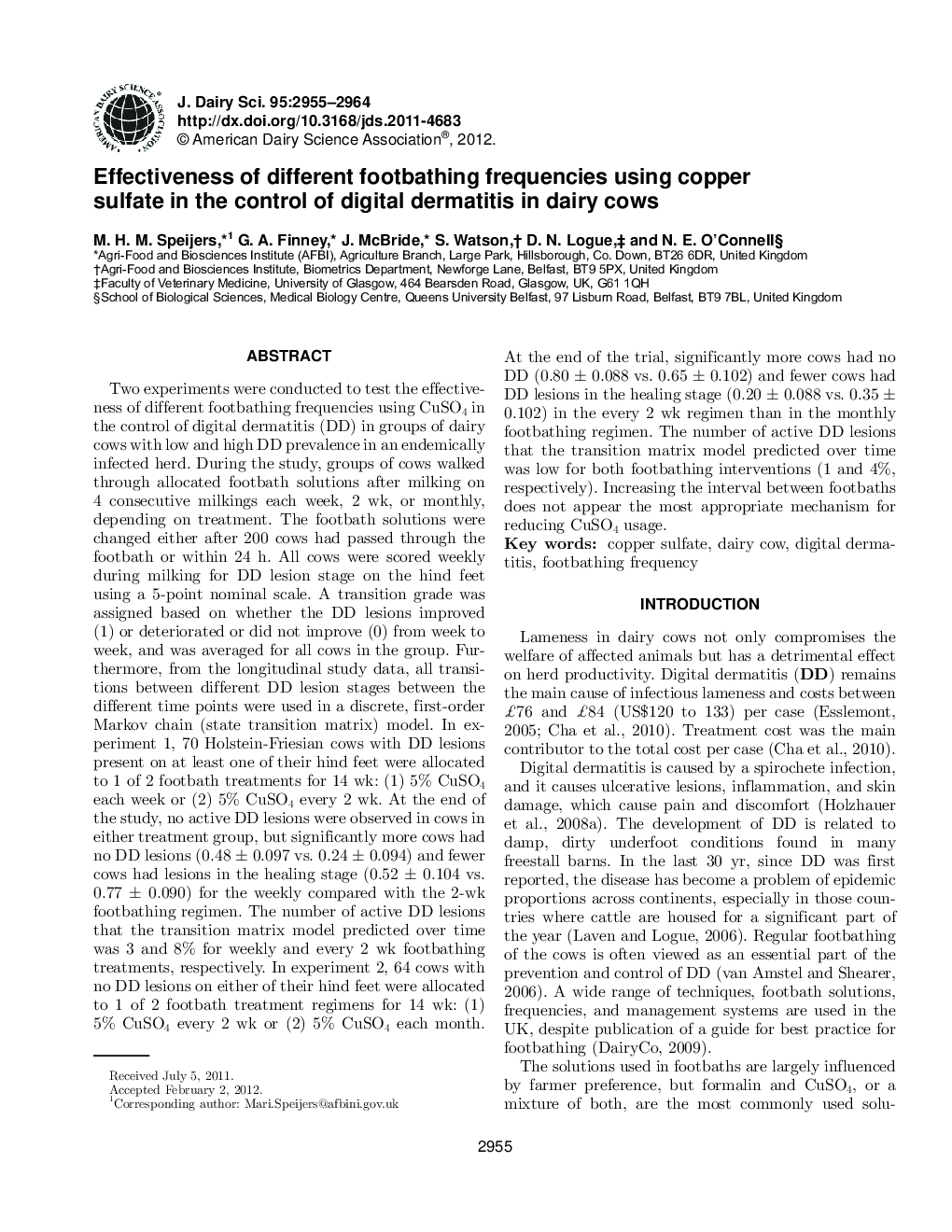| کد مقاله | کد نشریه | سال انتشار | مقاله انگلیسی | نسخه تمام متن |
|---|---|---|---|---|
| 10975624 | 1108035 | 2012 | 10 صفحه PDF | دانلود رایگان |
عنوان انگلیسی مقاله ISI
Effectiveness of different footbathing frequencies using copper sulfate in the control of digital dermatitis in dairy cows
دانلود مقاله + سفارش ترجمه
دانلود مقاله ISI انگلیسی
رایگان برای ایرانیان
موضوعات مرتبط
علوم زیستی و بیوفناوری
علوم کشاورزی و بیولوژیک
علوم دامی و جانورشناسی
پیش نمایش صفحه اول مقاله

چکیده انگلیسی
Two experiments were conducted to test the effectiveness of different footbathing frequencies using CuSO4 in the control of digital dermatitis (DD) in groups of dairy cows with low and high DD prevalence in an endemically infected herd. During the study, groups of cows walked through allocated footbath solutions after milking on 4 consecutive milkings each week, 2 wk, or monthly, depending on treatment. The footbath solutions were changed either after 200 cows had passed through the footbath or within 24 h. All cows were scored weekly during milking for DD lesion stage on the hind feet using a 5-point nominal scale. A transition grade was assigned based on whether the DD lesions improved (1) or deteriorated or did not improve (0) from week to week, and was averaged for all cows in the group. Furthermore, from the longitudinal study data, all transitions between different DD lesion stages between the different time points were used in a discrete, first-order Markov chain (state transition matrix) model. In experiment 1, 70 Holstein-Friesian cows with DD lesions present on at least one of their hind feet were allocated to 1 of 2 footbath treatments for 14 wk: (1) 5% CuSO4 each week or (2) 5% CuSO4 every 2 wk. At the end of the study, no active DD lesions were observed in cows in either treatment group, but significantly more cows had no DD lesions (0.48 ± 0.097 vs. 0.24 ± 0.094) and fewer cows had lesions in the healing stage (0.52 ± 0.104 vs. 0.77 ± 0.090) for the weekly compared with the 2-wk footbathing regimen. The number of active DD lesions that the transition matrix model predicted over time was 3 and 8% for weekly and every 2 wk footbathing treatments, respectively. In experiment 2, 64 cows with no DD lesions on either of their hind feet were allocated to 1 of 2 footbath treatment regimens for 14 wk: (1) 5% CuSO4 every 2 wk or (2) 5% CuSO4 each month. At the end of the trial, significantly more cows had no DD (0.80 ± 0.088 vs. 0.65 ± 0.102) and fewer cows had DD lesions in the healing stage (0.20 ± 0.088 vs. 0.35 ± 0.102) in the every 2 wk regimen than in the monthly footbathing regimen. The number of active DD lesions that the transition matrix model predicted over time was low for both footbathing interventions (1 and 4%, respectively). Increasing the interval between footbaths does not appear the most appropriate mechanism for reducing CuSO4 usage.
ناشر
Database: Elsevier - ScienceDirect (ساینس دایرکت)
Journal: Journal of Dairy Science - Volume 95, Issue 6, June 2012, Pages 2955-2964
Journal: Journal of Dairy Science - Volume 95, Issue 6, June 2012, Pages 2955-2964
نویسندگان
M.H.M. Speijers, G.A. Finney, J. McBride, S. Watson, D.N. Logue, N.E. O'Connell,